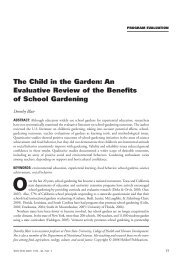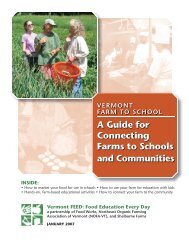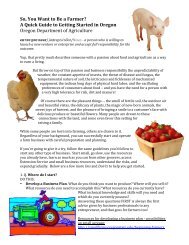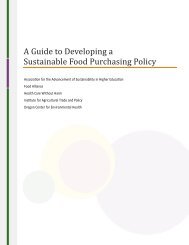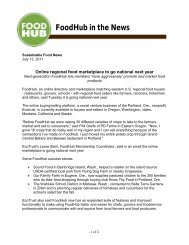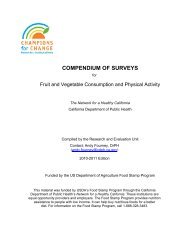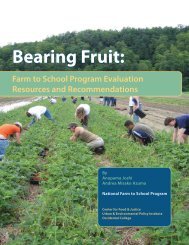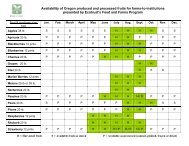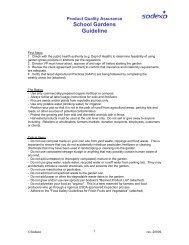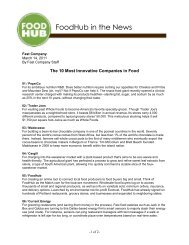Marketing Michigan Products to Schools: A Step-By-Step Guide
Marketing Michigan Products to Schools: A Step-By-Step Guide
Marketing Michigan Products to Schools: A Step-By-Step Guide
- No tags were found...
Create successful ePaper yourself
Turn your PDF publications into a flip-book with our unique Google optimized e-Paper software.
<strong>Step</strong> 1: Get Started - Addressing Food SafetyAccording <strong>to</strong> the <strong>Michigan</strong> Department of Agriculture, food establishments, includingschools, can obtain raw, uncut produce directly from growers. 3 To sell <strong>to</strong> schools (andother institutional food establishments like hospitals and colleges) farmers must becomean “approved source” or vendor for that school. This simply means that schools mustaccept/approve their vendors, and then add them <strong>to</strong> their invoicing and paymentsystems. Although farmers are not typically licensed by the <strong>Michigan</strong> Department ofAgriculture, “all producers are responsible <strong>to</strong> assure that their produce is safe andwholesome and must comply with applicable laws.” 4Good Agricultural Practices (GAP) AuditsOne way <strong>to</strong> help ensure food safety and sanitation on your farm and/or in your handlingfacility is <strong>to</strong> conduct a GAP (Good Agricultural Practices) and/or GHP (Good HandlingPractices) audit through the USDA with state audi<strong>to</strong>rs. Developed in 2001, GAP/GHP isa voluntary audit program that attempts <strong>to</strong> verify growers’ efforts <strong>to</strong> minimize food safetyand microbial hazards in fresh fruits and vegetables. In other words, growers candetermine how their on-farm food safety and sanitation practices compare <strong>to</strong> nationalstandards. More buyers are asking suppliers <strong>to</strong> have GAP or other food safety auditsdue <strong>to</strong> growing food safety concerns, but GAP is only required when selling products <strong>to</strong>USDA Commodity Procurement. Farm audits are on a per crop basis and occur atharvest time. Fees are required for the time and services of the audi<strong>to</strong>r. Before callingan audi<strong>to</strong>r <strong>to</strong> conduct a GAP audit on your farm, you can conduct a self-audit <strong>to</strong> be sureyou are prepared for an audi<strong>to</strong>r and will be likely <strong>to</strong> pass the audit. You can access the“USDA GAP/GHRP Audit Verification Checklist” athttp://www.ams.usda.gov/AMSv1.0/getfile?dDocName=STELPRDC5050869 and “GoodAgricultural Practices: A Self-Audit for Growers and Handlers” from the University ofCalifornia-Davis at http://ucce.ucdavis.edu/files/filelibrary/5453/4362.pdf.Aside from manda<strong>to</strong>ry general questions, growers can request which sections of theGAP audit they would like <strong>to</strong> pursue for certification, and do not have pursue all. GAP isdivided in<strong>to</strong> 5 sections known as “scopes” that cover the journey of food from farm <strong>to</strong>fork, with an optional food defense scope:1. Farm Review: water, sewage, manure, animals and wildlife, soils and landuse2. Field Harvest and Field Packing: worker sanitation and hygiene, and fieldharvesting and transportation3 <strong>Michigan</strong> Department of Agriculture. Buying Local – Approved Food Sources for Food Establishments. AccessedNovember 2009 at http://www.mi.gov/mda/0,1607,7-125-50772_51200_51231-213569--,00.html.4Ibid.<strong>Michigan</strong> State University • C.S. Mott Group for Sustainable Food Systems • www.mifarm<strong>to</strong>school.msu.edu16 of 47



